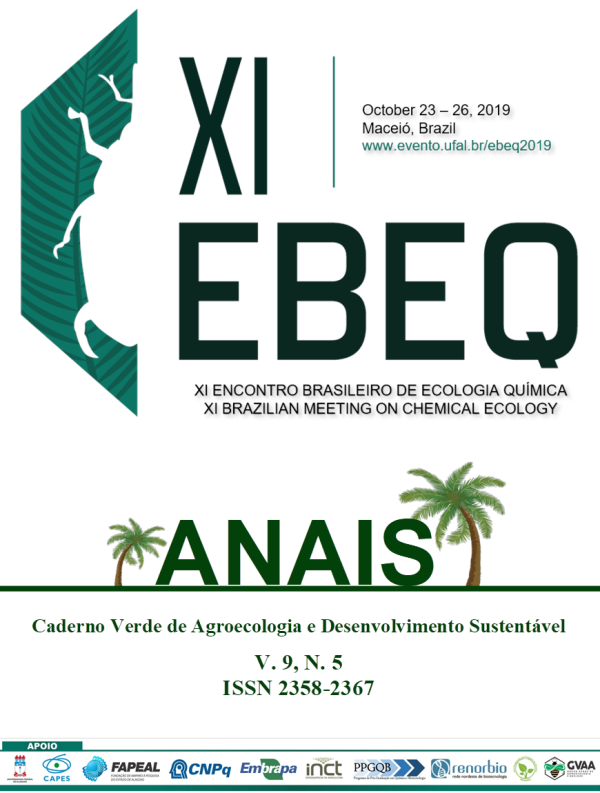SIGNIFICANT EFFECT OF ARBUSCULAR MYCORRHIZAL FUNGI INOCULATION ON MONOTERPENES BIOSYNTHESIS IN RED CLOVER
Palavras-chave:
ARBUSCULAR MYCORRHIZAL FUNGI (AMF), GERANYL PYROPHOSPHATE, (S)-LIMONENEResumo
Red Clover (Trifolium pratense L.) is a legume with important economic value in seed industry and animal production. This short-lived perennial species is one of the most important legume crops in Chile used primarily in short-rotation pastures, grazing and cutting. However, T. pratense yields decline quickly after two years, because several factors including root rot and infestation by the root borer Hylastinus obscurus (Marsham) (Coleoptera: Curculionidae). This curculionid is the most important insect pest attacking this foraging crop. Both larvae and adults feed into the roots when they construct galleries causing a significant reduction in levels of production and persistence of red clover. Arbuscular mycorrhizal fungi (AMF), are symbiotic organisms found on 80% of vascular plants, these biotic factors modify the primary and secondary metabolism being able to improve the bioproduction of secondary metabolites. Currently, the role of semiochemical in the interaction between H. obscurus and red clover plants has been widely studied for our group. Previously, (S)-limonene identified from the aerial part elicit a repellent effect from this curculionid. With the purpose of producing new cultivar with the ability of releasing more amount of this repellent, the study of their biosynthesis in red clover result a key step, besides the effect of biotic factors on this enzymatic production. We evaluated the enzymatic production of monoterpenes in Superqueli-INIA cultivar supplemented with two commercial AMF inoculums and using geranyl pyrophosphate (GPP) as precursor. The enzymatic monoterpene production was recorded by head-space-gas chromatograph. Our results showed the presence of β-pinene, myrcene, (S)-limonene, linalool, (-)-isopiperitenone, perillyl alcohol among others. (S)-Limonene production in enzymatic extracts was significantly increased in plants inoculated with AMF, suggesting a significant role of AMF in red clover secondary metabolism.Downloads
Publicado
Como Citar
Edição
Seção
Licença
Termo de cessão de direitos autorias
Esta é uma revista de acesso livre, em que, utiliza o termo de cessão seguindo a lei nº 9.610/1998, que altera, atualiza e consolida a legislação sobre direitos autorais no Brasil.
O(s) autor(es) doravante designado(s) CEDENTE, por meio desta, publica a OBRA no Caderno Verde de Agroecologia e Desenvolvimento Sustentável, representada pelo Grupo Verde de Agroecologia e Abelhas (GVAA), estabelecida na Rua Vicente Alves da Silva, 101, Bairro Petrópolis, Cidade de Pombal, Paraíba, Brasil. Caixa Postal 54 CEP 58840-000 doravante designada CESSIONÁRIA, nas condições descritas a seguir:
O CEDENTE declara que é (são) autor(es) e titular(es) da propriedade dos direitos autorais da OBRA submetida.
O CEDENTE declara que a OBRA não infringe direitos autorais e/ou outros direitos de propriedade de terceiros, que a divulgação de imagens (caso as mesmas existam) foi autorizada e que assume integral responsabilidade moral e/ou patrimonial, pelo seu conteúdo, perante terceiros.
O CEDENTE mantêm os direitos autorais e concedem à revista o direito de divulgação da OBRA, com o trabalho simultaneamente licenciado sob a Licença Creative Commons do tipo atribuição CC-BY.
O CEDENTE têm autorização para distribuição não-exclusiva da versão do trabalho publicada nesta revista.
O CEDENTE têm permissão e são estimulados a publicar e distribuir seu trabalho online (ex.: em repositórios institucionais ou na sua página pessoal) a qualquer ponto antes ou durante o processo editorial, já que isso pode gerar alterações produtivas, bem como aumentar o impacto e a citação do trabalho publicado.










